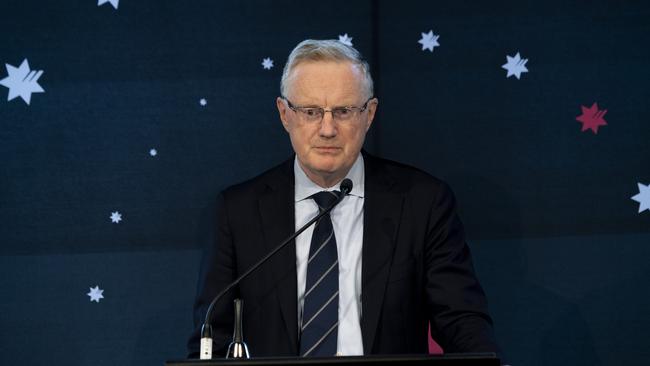Wages growth to underpin RBA’s interest rates direction in 2024
The RBA will feel vindicated by Federal Open Market Committee minutes indicating members think slower US rate rises will soon be appropriate.

Business
Don't miss out on the headlines from Business. Followed categories will be added to My News.
The Reserve Bank will feel vindicated by FOMC minutes showing a substantial majority of members thought a slower pace of US rate rises would “likely soon be appropriate”, and staff economists thought the chance of a US recession in the next year was almost as likely as their baseline.
With weak US purchasing managers’ data adding to signs of easing inflationary pressure that may allow the Fed to slow the pace of rate hikes, the Australian dollar rose the most in two weeks.
Stocks and bonds rallied, with share benchmarks at multi-month highs and the US 10-year bond yield at an almost two-month low. A risk-on mood may now continue through year end, depending on the outcome of US employment and inflation data, Fed speak and the FOMC meeting in mid December.
But while the inflationary impact of supply chain disruption and economic reopening after the pandemic is clearly fading, the RBA can’t be sure it has done enough to lower inflation to its target.
When the RBA downshifted to a 25 basis point rate hike in October, it said the cash rate had risen substantially in a short space of time, and while more increases were needed, inflation was expected to fall next year after a resolution of supply-chain problems, commodity price falls and rate hikes.
Domestic inflation, wages and employment data have subsequently been stronger than expected, US inflation data have been lower than expected, the ratio of US inventories to sales has soared to its highest since late 2021, and China-US shipping rates have fallen off a cliff.
However, Australian inflation, wages and employment data have been stronger than expected.

RBA governor Philip Lowe’s comments this week on the risk of a wage-price spiral show he remains wary of prematurely ending rate hikes as upward pressure on wages threatens to let the inflation genie out of the bottle. Attempts to match inflation with wage increases in the 1970s and ’80s “tended to be a disaster” and keeping wages growth broadly in the current range or “a bit higher” would be relatively “painless” once supply-side problems were resolved,” he said.
The federal government immediately pushed back on the acceptability of declining real wages.
But the Reserve Bank of New Zealand may be the canary in the coal mine in terms of the sustained interest rate hikes that may be needed to return inflation back to target in a reasonable time frame.
While upscaling its rate hike by 75 bps to 4.25 per cent as expected this month, the RBNZ said its official cash rate “needs to reach a higher level, and sooner than previously indicated, to ensure inflation returns to within its target range over the medium term”.
“Core consumer price inflation is too high, employment is beyond its maximum sustainable level, and near-term inflation expectations have risen,” the RBNZ said.
Meanwhile, in Australia, ANZ economists pushed out the timing of their forecasts for the first interest rate cut by the RBA this cycle after increasing their wages growth forecast.
ANZ still sees the overnight cash rate peaking at 3.85 per cent in May 2023.
That’s in line with market pricing, but about 50 bps more than most economists expect.
But while previously expecting rate cuts to start in August 2024, ANZ now expects the RBA will keep the cash rate at 3.85 per cent through November 2024.
“Wages growth in Australia has been slower to respond to labour market tightness than in other countries, but the September quarter data showed momentum building in the private sector,” said ANZ head of Australian economics David Plank.

He expects nominal wages growth to hit 3.4 per cent by year end, before accelerating to a peak of 4.3 per cent in late 2023, higher than a previous forecast peak of 3.9 per cent.
His expectation that nominal wages growth will “prove to be quite persistent is unchanged”, with that rate expected to remain at or above 4 per cent over 2024.
But real wages are expected to keep falling until at least late 2023.
“The tight labour market, encompassing very high job vacancy rates across a broad range of industries, will continue to put upward pressure on wages growth,” Mr Plank said.
Offsetting factors include public sector wage caps, the prevalence of non-wage and non-base wage measures to attract and retain workers, and the 0.5 percentage point Superannuation Guarantee increases from 2021 to 2025.
But the overseas experience shows wage dynamics can shift more quickly than expected.
CPI inflation is consequently forecast to be a little higher than previously forecast, ending 2024 at 3 per cent on-year rather than 2.8 per cent, albeit ANZ still sees headline inflation slowing quite sharply next year, largely reflecting easing global and supply-side pressures.
Trimmed mean or core inflation, on the other hand, is expected to be “a lot stickier” than headline inflation, reflecting the momentum in domestic pressures including wages growth.
“Higher inflation and wages growth for longer pose a challenge for the RBA,” Mr Plank said.
But sees the RBA trying to stay on the “narrow path” of keeping the economy on an “even keel” if it can, and so hasn’t increased his expected cash rate peak.
“By mid-2023 we think there will be clear evidence that labour market pressures are easing,” he said.
“At the same time, the expected sharp decline in headline inflation will give the RBA some breathing room regarding inflation expectations. This creates the opportunity for an extended pause, which will morph into a complete stop if the economy tracks the way we expect.”
Originally published as Wages growth to underpin RBA’s interest rates direction in 2024



